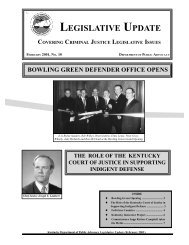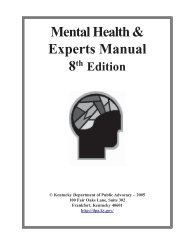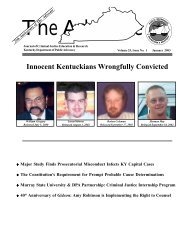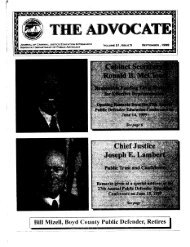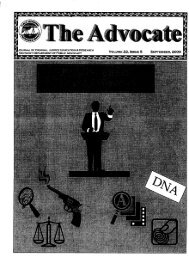May 2002 - Department of Public Advocacy
May 2002 - Department of Public Advocacy
May 2002 - Department of Public Advocacy
You also want an ePaper? Increase the reach of your titles
YUMPU automatically turns print PDFs into web optimized ePapers that Google loves.
Continued from page 37<br />
during the commission <strong>of</strong> the <strong>of</strong>fense. (The requirements for<br />
KRS 218A.992, Kentucky’s firearm enhancement statute, are<br />
very similar.) The Court holds that the government presented<br />
no evidence at sentencing that Lucas owned the gun<br />
or the car or knew the gun was in the glove compartment.<br />
The gun was not used or displayed during the commission <strong>of</strong><br />
the <strong>of</strong>fense. No fingerprints were lifted from the gun. Another<br />
individual occupied the vehicle. The case is distinguishable<br />
from U.S. v. Paulk, 917 F.2d 879 (5 th Cir. 1990). In<br />
that case defendant was arrested away from his car and an<br />
unloaded, inoperable gun was found in the glove compartment.<br />
Paulk, however, admitted ownership <strong>of</strong> the gun.<br />
Because <strong>of</strong> the lack <strong>of</strong> evidence that Lucas possessed, actually<br />
or constructively, the firearm, the district court’s determination<br />
to the contrary was clearly erroneous. This case is<br />
very unusual, considering the 6 th Circuit’s prior holdings in<br />
firearm enhancement cases. The Court seems to be demanding<br />
that prosecutors at least put on some pro<strong>of</strong> <strong>of</strong> possession<br />
before enhancement can occur.<br />
Dissent by Siler<br />
Judge Siler dissents. He argues that “possession not only<br />
may be constructive, but a defendant need not have exclusive<br />
possession <strong>of</strong> property to be found in possession <strong>of</strong> it.<br />
Joint possession will suffice.” He notes that affirmance <strong>of</strong><br />
the firearm enhancement would be appropriate under the “fortress<br />
theory.” U.S. v. Critton, 43 F.3d 1089, 1096-1097 (6 th Cir.<br />
1995).<br />
U.S. v. Haywood<br />
280 F.3d 715 (6 th Cir. 2/21/02)<br />
Another strong case for our clients! Haywood was convicted<br />
<strong>of</strong> possession with intent to distribute 18 grams <strong>of</strong><br />
crack cocaine on the date <strong>of</strong> August 1, 1997. To prove that he<br />
intended to distribute the drugs he possessed on August 1,<br />
1997, the government <strong>of</strong>fered pro<strong>of</strong> that Haywood was subsequently<br />
arrested on December 21, 1997, for possessing 1.3<br />
grams <strong>of</strong> crack cocaine. Haywood objected to the admission<br />
<strong>of</strong> this evidence, arguing it was irrelevant and unfairly prejudicial,<br />
but the trial court overruled the objection. The 6 th<br />
Circuit reverses and remands for a new trial.<br />
The August 1997 <strong>of</strong>fense occurred as a result <strong>of</strong> a controlled<br />
buy by FBI informant Spears. The FBI orchestrated the buy<br />
as part <strong>of</strong> an investigation into illegal drug sales by Michael<br />
Liles, a friend <strong>of</strong> Haywood. Spears approached Haywood<br />
about purchasing some crack. Haywood told Spears to come<br />
to a specified apartment at South Scott Street in Lima, Ohio.<br />
Both Haywood and Liles were present during the drug buy.<br />
At trial, Spears testified that Haywood sold him the crack.<br />
Liles, however, testified that he sold Spears the drugs and<br />
FBI agent Spicocchi corroborated this testimony by testifying<br />
that Spears initially told the FBI that Liles sold him the<br />
crack.<br />
In an effort to boost its position that Haywood sold Spears<br />
THE ADVOCATE Volume 24, No. 3 <strong>May</strong> <strong>2002</strong><br />
38<br />
the drugs on August 1, the government introduced testimony,<br />
over defense objection, <strong>of</strong> Lima police <strong>of</strong>ficers that<br />
they found drugs on Haywood on December 1, 1997.<br />
FRE 404(b) analysis, like KRE 404(b) analysis, requires that a<br />
trial court faced with other bad acts evidence perform a threestep<br />
analysis before allowing evidence <strong>of</strong> the other bad act<br />
to come in. First, there must be evidence that the other act<br />
occurred. In the case at bar, Haywood concedes that he<br />
possessed crack on December 1, 1997 so this prong is not at<br />
issue. Second, the court must decide whether the other act is<br />
probative <strong>of</strong> a material issue other than character. Finally, the<br />
prejudicial effect <strong>of</strong> the evidence cannot substantially outweigh<br />
the probative value.<br />
Evidence <strong>of</strong> Subsequent Possession <strong>of</strong> Crack Not Probative<br />
<strong>of</strong> Intent to Distribute Crack 5 Months Earlier: Not<br />
“Substantially Similar and Reasonably Near in Time”<br />
The 6 th Circuit first holds that evidence <strong>of</strong> the December 1 st<br />
crack possession was not probative <strong>of</strong> a material issue. The<br />
evidence was <strong>of</strong>fered for an admissible purpose, intent to<br />
distribute crack cocaine. Furthermore, intent was “in issue”<br />
during Haywood’s trial. However, the inquiry is narrower<br />
than that. The issue is whether the evidence <strong>of</strong> Haywood’s<br />
December 1997 possession is probative <strong>of</strong> intent to distribute<br />
crack cocaine on August 1, 1997. Does the evidence<br />
relate to conduct that is “substantially similar and reasonably<br />
near in time” to the specific intent <strong>of</strong>fense at issue U.S.<br />
v. Blankenship, 775 F.2d 735, 739 (6 th Cir. 1985). The Court<br />
first decides that possession <strong>of</strong> a small amount <strong>of</strong> crack cocaine<br />
for personal use on December 1 st is not substantially<br />
similar to the <strong>of</strong>fense <strong>of</strong> possession <strong>of</strong> crack cocaine with the<br />
intent to distribute five months earlier. In so holding, the<br />
Court declines to join with the 5 th , 8 th , and 11 th Circuits, and<br />
instead adopts the approach <strong>of</strong> the 7 th and 9 th Circuits. The<br />
Court notes that the government failed to <strong>of</strong>fer testimony<br />
that 1.3 grams is an amount inconsistent with personal use,<br />
nor was there any circumstantial evidence that would support<br />
the conclusion that Haywood intended to distribute the<br />
crack cocaine. Haywood had not divided the crack cocaine<br />
into individual allotments for sale. He did not possess a large<br />
amount <strong>of</strong> cash or a firearm either. Absent evidence that<br />
Haywood intended to distribute the 1.3 grams <strong>of</strong> crack cocaine,<br />
the December 1997 crack cocaine possession had no<br />
bearing on whether he intended to distribute the crack cocaine<br />
in his possession on August 1, 1997.<br />
Evidence <strong>of</strong> Later Crack Possession<br />
Also More Prejudicial than Probative<br />
The Court further holds that even if the December 1997 <strong>of</strong>fense<br />
were substantially similar to the August 1997 <strong>of</strong>fense,<br />
evidence <strong>of</strong> the subsequent <strong>of</strong>fense would be more prejudicial<br />
than probative. First, the evidence <strong>of</strong> the 1997 possession<br />
had a “powerful and prejudicial impact.” It “brand[ed]<br />
Haywood as a criminal possessing crack cocaine” and “further<br />
invited the jury to conclude that Haywood ‘is a bad<br />
person. . . and that if he ‘did it [once] he probably did it



